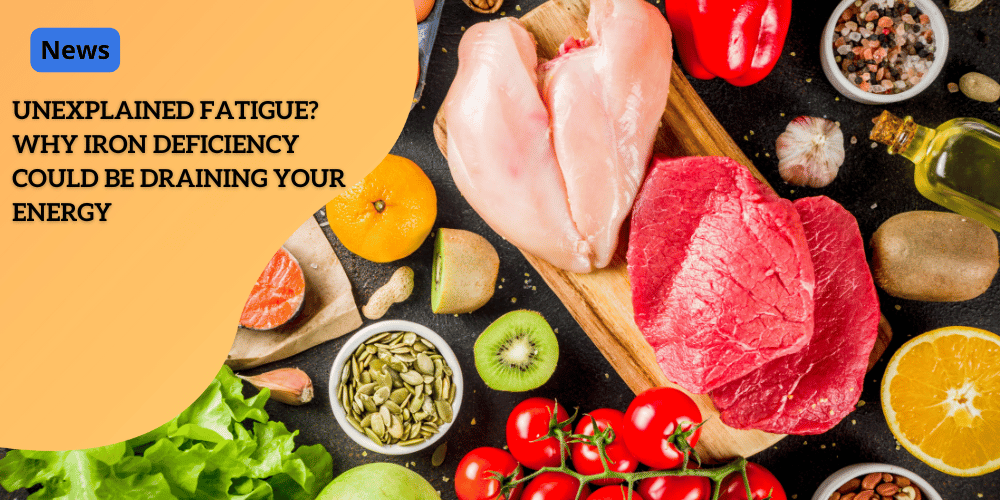Unexplained Fatigue? Why Iron Deficiency Could Be Draining Your Energy

Anúncios
Understanding Iron’s Role in Your Body
Iron is an unsung hero in the world of nutrients, playing a pivotal role in the function of nearly every cell in our bodies.
It is one of those minerals that your body cannot do without, as it’s crucial for a myriad of cellular activities and overall health.
Anúncios
Essential for Cellular Function
Virtually every cell in your body requires iron to function properly.
Iron is a key component of various proteins and enzymes that facilitate essential biological processes.
Anúncios
Without adequate iron, these processes can slow down or malfunction, leading to a cascade of health issues.
Iron also aids in DNA synthesis, which is fundamental for cell growth and division.
This explains why iron deficiency can have widespread effects on the body, manifesting in symptoms like fatigue, weakened immunity, and even cognitive impairment.
Oxygen Transport in Blood
One of the most critical functions of iron is its role in the transportation of oxygen in the blood.
Iron is a central component of hemoglobin, the protein in red blood cells that binds to oxygen in the lungs and carries it to tissues and organs throughout the body.
Without sufficient iron, your body cannot produce enough healthy red blood cells, leading to a condition known as iron deficiency anemia.
Anemia diminishes your blood’s ability to carry oxygen, resulting in persistent fatigue, weakness, and shortness of breath.
Energy Production and Protein Building
Iron is also indispensable in energy metabolism and protein synthesis. It is a key player in the body’s energy production process, helping to convert nutrients into energy.
This is why iron deficiency often results in reduced stamina and sluggishness.
Moreover, iron is involved in the formation of myoglobin, a protein that supplies oxygen to muscles, supporting both immediate and sustained physical activity.
Iron also contributes to the synthesis of essential proteins and enzymes that your body needs to grow and repair tissues.
This includes the building and repair of skin, hair, nails, and muscle tissue.
Thus, the signs of iron deficiency might include brittle nails, hair loss, and delayed wound healing.
Understanding the crucial roles that iron plays in your body is the first step toward recognizing its importance in your overall health.
From ensuring efficient oxygen transport to supporting cellular functions and energy production, iron is indeed a powerhouse nutrient.
Next, we delve into the common causes of iron deficiency and how you can identify if you might be affected.
Common Causes of Iron Deficiency
Iron deficiency can impact anyone, but understanding its common causes can help you take steps to prevent or manage it effectively.
Here are some key factors that can deplete iron levels:
Inadequate Dietary Iron Intake
One of the most straightforward causes of iron deficiency is not getting enough iron through your diet.
This can happen if your meals lack iron-rich foods like red meat, poultry, fish, lentils, beans, nuts, and fortified cereals.
Over time, a diet low in iron can lead to insufficient levels in your body, leaving you feeling tired and weak.
Vegetarians and vegans need to pay special attention to ensure they consume enough plant-based sources like spinach, quinoa, tofu, and legumes to meet their iron needs.
Menstruation and Pregnancy-Related Iron Loss
For many people, menstruation and pregnancy can significantly impact iron levels.
Heavy menstrual bleeding is a common contributor to iron deficiency in women of reproductive age.
During pregnancy, the body’s demand for iron increases to support the growing fetus and placenta.
This increased need, combined with the typical blood loss during childbirth, can often lead to iron deficiency or anemia if not properly managed.
It’s essential for pregnant individuals to monitor their iron levels closely and consider iron supplements upon their healthcare provider’s advice.
Gastrointestinal Issues Affecting Absorption
Even if you’re consuming enough iron-rich foods, your body might still not absorb enough iron due to gastrointestinal issues.
Conditions like celiac disease, Crohn’s disease, and ulcerative colitis can damage the intestines, impairing their ability to absorb nutrients effectively.
Additionally, stomach surgeries that involve the removal of parts of the stomach or intestines can hinder iron absorption.
Medications that reduce stomach acid can also impact how well your body assimilates iron, as a certain level of stomach acid is necessary for optimal iron absorption.
Understanding these causes can help you identify potential risks and take proactive steps.
Be mindful of your diet, watch for signs of excessive blood loss, and consult healthcare professionals if you suspect an absorption issue.
Regular monitoring and appropriate dietary choices are key to maintaining healthy iron levels and overall well-being.
Recognizing the Signs
Iron deficiency, a common but often overlooked condition, can manifest in several subtle and not-so-subtle ways.
It’s essential to be aware of these signs to address the deficiency early and effectively.
 Pay attention to the signs
Pay attention to the signs
Persistent Fatigue and Weakness
Feeling unusually tired despite getting ample sleep? Iron deficiency could be the culprit.
Since iron is crucial for producing hemoglobin in red blood cells, which carries oxygen from your lungs to the rest of your body, low iron can lead to decreased oxygen delivery.
This reduces energy production, making you feel persistently fatigued and weak.
Lightheadedness and shortness of breath during everyday activities are additional red flags indicating your body isn’t getting enough oxygen due to low iron levels.
Mood Changes, Depression, and Difficulty Focusing
Iron deficiency doesn’t just sap your physical energy; it can also impact your mental health.
Low iron levels can lead to mood swings and even depression.
Since iron is involved in producing neurotransmitters that regulate mood, such as dopamine and serotonin, a deficiency can disrupt your mental balance.
Difficulty focusing and poor cognitive function can also stem from insufficient oxygen supply to the brain, further hampering daily productivity and overall well-being.
Unique Symptoms Like Pica and Cold Sensitivity
Some symptoms of iron deficiency are less commonly recognized but equally telling.
Pica, a craving for non-food items like ice, dirt, or clay, is a distinctive sign of severe iron deficiency anemia.
While the exact cause is unknown, it’s believed that chewing on these substances temporarily increases alertness and reduces the feelings of fatigue associated with anemia.
Another symptom is cold sensitivity; if you often feel cold when others don’t, it might be due to lower iron levels.
Iron helps regulate body temperature, and without enough of it, your body struggles to stay warm.
Recognizing these signs is the first step towards addressing iron deficiency.
Ensuring that you’re attentive to your body’s signals can help in preventing the condition from worsening.
Taking action early, whether through diet, supplements, or medical treatment, can significantly improve your quality of life and energy levels.
Next, we will delve into how understanding these signs can lead to effective diagnosis and treatment options to manage iron deficiency.
Diagnosis and Treatment Options
Importance of Regular Blood Tests
When it comes to diagnosing iron deficiency, regular blood tests play a crucial role.
These tests measure the levels of various markers, such as hemoglobin, hematocrit, and ferritin, which help in identifying iron deficiency anemia.
Early detection through blood tests allows for timely intervention, preventing the condition from worsening and leading to more severe health complications.
Oral Iron Supplements vs. IV Iron Therapy
Once iron deficiency is diagnosed, the treatment approach depends on the severity of the deficiency and the patient’s specific circumstances. Here are the two main options:
Oral Iron Supplements
For many individuals, oral iron supplements are the first line of treatment.
These tablets or capsules are taken daily and work to gradually replenish the body’s iron stores.
While effective, oral supplements can take several months to fully correct iron levels.
Common side effects include constipation and stomach upset.
It’s essential to follow your healthcare provider’s guidance regarding dosage and duration to minimize potential side effects and ensure the treatment’s effectiveness.
IV Iron Therapy
Intravenous (IV) iron therapy is a quicker method to restore iron levels, often producing near-instantaneous results.
This option is particularly beneficial for individuals who have difficulty absorbing iron through the gastrointestinal tract or who suffer from conditions causing heavy menstrual bleeding.
IV iron bypasses the digestive system, injecting iron directly into the bloodstream.
Although effective, this treatment is typically reserved for more severe cases due to its higher cost and the need for medical supervision during administration.
Potential Need for Blood Transfusions in Severe Cases
Severe iron deficiency anemia may necessitate more intensive treatment, such as blood transfusions.
Blood transfusions are usually considered when hemoglobin levels are dangerously low, posing a significant risk to health.
However, this is a last resort, employed only when absolutely necessary.
Blood transfusions provide an immediate increase in red blood cells and hemoglobin levels, offering quick relief from severe symptoms.
This option is avoided unless all other treatments prove insufficient or the patient’s condition is critical.
By addressing iron deficiency through these targeted treatments, patients can experience a significant improvement in energy levels and overall well-being.
Proper management and timely intervention are key to preventing complications and ensuring a swift recovery.
Prevention and Dietary Solutions
Addressing iron deficiency isn’t just about treatment; prevention is equally crucial.
Maintaining a diet rich in iron is an excellent way to keep your iron levels in check.
Iron-Rich Food Sources
When it comes to boosting your iron intake through food, variety matters.
There are two types of dietary iron: heme iron, found in animal products, and non-heme iron, found in plants.
Meat-Based Options
Heme iron is more readily absorbed by the body. Here are some rich sources:
- 🥩 Red Meat: Beef, pork, and lamb are top contributors.
- 🥩 Poultry: Chicken and turkey also offer good levels of iron.
- 🥩 Fish and Shellfish: Options like salmon, tuna, and shrimp are excellent choices.
Plant-Based Options
Non-heme iron might not be as easily absorbed, but it still plays a significant role:
- 🫘 Leafy Greens: Spinach, kale, and Swiss chard are fantastic options.
- 🫘 Legumes: Beans, lentils, and chickpeas are not only iron-rich but also beneficial for overall nutrition.
- 🫘 Nuts and Seeds: Pumpkin seeds and cashews can be great additions to your diet.
- 🫘 Fortified Foods: Some cereals and grains are fortified with iron, making them a useful option, especially for vegetarians and vegans.
Special Considerations for Vegetarians and Vegans
Maintaining adequate iron levels requires careful planning if you avoid meat, but it’s entirely feasible:
- 💊 Combine with Vitamin C: Pairing iron-rich foods with vitamin C can enhance absorption. Think bell peppers, oranges, and strawberries.
- 💊 Diversify Your Diet: Incorporate a variety of plant-based iron sources to ensure you’re getting enough. Include tofu, tempeh, and fortified plant milks.
- 💊 Monitor Consumption of Inhibitors: Some foods and beverages, like tea and coffee, can inhibit iron absorption if consumed with meals. It’s helpful to drink these between meals instead.
Balanced Diet Strategies
Eating a balanced diet that includes both iron-rich foods and enhancer combinations is key.
Here are some strategies to keep your iron levels in the sweet spot:
- 🍊 Mix Food Groups: Pair iron-rich foods with those high in vitamin C. For example, a spinach salad with strawberries.
- 🍊 Include Protein Sources: Complement legumes with other proteins to balance your diet.
- 🍊 Limit Iron Absorption Inhibitors: Avoid excessive consumption of calcium at the same time as iron-rich meals.
Ensuring you have a varied and balanced diet is not only beneficial for preventing iron deficiency but also for overall health. Regular check-ins with your healthcare provider and blood tests can help you stay on track and address any iron deficiency issues promptly.
Maintain a holistic approach to your diet, and your body will thank you for the care and attention, especially when it comes to preventing iron deficiency.







